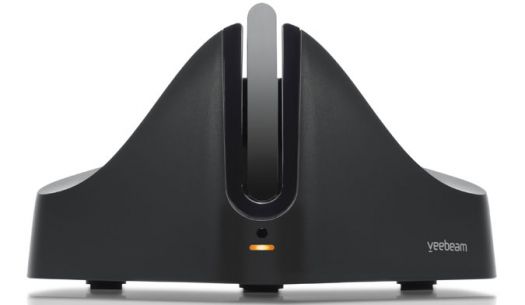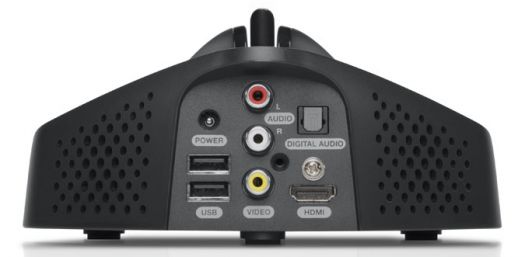The home computer has increasingly become the hub of home entertainment for many consumers, with its audio and video files stored locally on the hard drive as well as the ability to stream content from the internet. While there have been plenty of advances to TVs and set-top boxes in order to make them more internet-friendly, nothing short of a full-fledged PC or Mac can do everything that power users would excpect, right down to finding the latest oddball video clip or displaying the hottest new website in HD.
The trouble with connecting a computer to the home theater, once you get past the phyical wiring requirements (which are covered in our "how to connect a PC to your TV" article) is typically the fan noise, and the incongruous form factor, and of course the need for a mouse and keyboard, which might be some of the reasons why this approach has never caught on. Google TV has promised us the world(wide web) in our living room, but so far the technology has been hobbled by an abundance of deliberately blocked content. Ever wish there was just some easy, agnostic way to see/hear in the home theater all of the same infotainment we enjoy on the computer screen?
Veebeam is claiming a solution in the form of their simple, affordable Veebeam HD. This add-on device arrives in two pieces, namely a curiously shaped little set-top box and a USB plug-in antenna. More on the hardware in a moment, but as to what this product can do, well....
Limitless
In short, the Veebeam HD represents a different way to get all of our computer audio and video to the home theater, wirelessly, maintaining high-definition specifications. That would be impressive enough for content stored locally, or on removable media, but now the entire internet is at our disposal.
Have an older TV that doesn't support Netflix streaming? No problem. With Veebeam HD, you'll be ready for Netflix streaming and more. Want to access the free Hulu service without having to pay $7.99/month for the "premium" Hulu Plus version on your set top box? Also, no longer a problem. Frustrated by Google TV's incompatibility with a great site like ABC.com? Free at last! Are you an HBO subscriber otherwise unable to access video on demand? With the HBO GO app running on your PC and a Veebeam stiching out of your USB port, you're good to, y'know, go. This is in addition to the limitless realm of YouTube certainly, but since that support is being built into more and more devices, let's be bold and visit any site, just because we can.

The larger of the two physical components is the wireless receiver, which connects to the television--or to an audio/video receiver--via HDMI or a host of other options. The wee USB antenna attaches to the PC or Mac, enabling communication between the computer and the home theater. Although it will work with a much bulkier desktop computer, it is ideally suited to work with laptops because there is no Veebeam remote control, so everything is done on the computer itself: finding and playing video, entering URLs and passwords, managing slide shows, etc. An integrated keyboard and trackpad or even an optional mouse go a long way.
Sooner or later (before we buy?) we will need to confirm that our computer is ready to work with the Veebeam HD, and so we should download and run the Compatibility Tool software. Specific minimum system requirements are listed below, but this automated program checks that the computer in question contains sufficiently robust graphics processing, sound capabilities compatible with Veebeam's audio driver, and adequate basics (primarily CPU speed and available memory) to reproduce videos on the TV.
In a clever bit of designery, the USB antenna can be stored in a notch on the front of the Veebeam HD receiver when not in use. Returning the antenna to its nest keeps it from dropping between the sofa cushions, but this also appears to be the only way to power off the base unit. It just plugs into a free port on the laptop, where it is immediately recognized and automatically installed. The proprietary "Wireless USB" connection is a secure point-to-point link between computer and receiver, superior to conventional Wi-Fi for its greater bandwidth and security and reduced interference over short distances. The roughly-35MB Veebeam application software then needs to be downloaded and installed from the Veebeam.com website.

The curvalicious set-top box is not really shelf/stack-friendly, but at least it's compact. It requires AC power via the bundled adapter and can do its entire A/V act via its HDMI output (cable not included), or we can hook up via digital optical or analog stereo audio and/or composite video if so desired. Its little yellow indicator light matches that on the USB antenna. Once hardware and software were installed--speedily and without a hint of grief--the Veebeam logo magically appeared on my Samsung plasma, followed by a 50-inch (measured diagonally) representation of my desktop screen!
A la Modes
What I was now seeing was Veebeam HD's default Screencasting Mode, which simply mirrors the computer on the TV. The only things missing were the cursor when I trackpadded around, and DVD chapter titles and similar metadata during DVD playback in Windows Media Player. Screencasting introduces a slight buffering delay between the source and the display, as the desktop image is captured in real time, converted and encoded at a high-speed H.264 profile at 1,920x1,080p/60Hz (assuming we step up from the default 1,280x720p resolution, easy enough under Settings in Windows). This stream is then delivered to the receiver using the DLNA protocol, although the aforementioned lag pretty much rules out any gaming application for this device.
I initially noted about a two-second delay between the laptop and TV, but playing higher-quality content such as 720p HD home videos extended this to as much as six seconds. It's a little disorienting but not really an issue because we likely won't be referring to the laptop all that much once the show begins, since the real action will be on the big screen. Veebeam automatically mutes the laptop speakers when the device is active.
Our other option is Video Play-To Mode, which essentially isolates the video playback, streaming it in the background from a special user interface, wherein we can also set up a video playlist. Only the video playback is sent to the TV, giving us the freedom to multitask on the computer itself. Play-To promises enhanced quality for downloaded videos--not applicable to live websites--because in some cases (i.e. an H.264 stream already exists within the file) the video will only be repacked along the way, for minimal degradation, while in other cases it will actually be transcoded.

This mode seemed like a no-brainer to us, as we here at Big Picture Big Sound are seldom just watching TV when we're sitting on the couch, plus we're all about quality. As long as we have the proper codecs on our computer, the Veebeam HD can open any video we throw at it. Thankfully, free codec bundles are made readily available for download from Veebeam to cover any gaps in our repertoire. The user interface is a little bit clunky, as we need to go into Settings and turn off Screencasting in order to engage Play-To, hopefully something more elegant is in the works. An audio-only mode is also provided in case you simply want to stream iTunes or Window Media Audio playlists to your stereo system for the aural delight of your housemates or party guests.
Vee for Video
In truth I did not see a major difference between the video performance in Screencasting and Play-To modes. We're typically dealing with heavily compressed digital video on the computer, be they read off of a hard disk drive or streamed from the internet. Over the Veebeam HD, the step up from standard-definition to high-definition video files was obvious however, with a much sharper and more colorful image as we would expect, and a genuinely enjoyable experience on the big screen.
One glaring exception was the introduction of "shearing," a bizarre and unwelcome effect whereby the image looks like it was split in two across the middle and reassembled on the screen with less-than-perfect alignment. This was a persistent problem across many of my tests.
Another significant difference was noted when I played a variety of DVDs on my connected laptop. (I'm not currently in possession of Blu-ray-enabled laptop.) Thanks to the proximity of the source computer to the TV, we have the ability to compare its "pure" image to that being Veebeamed, and the process apparently introduced a thin additional layer of geometric artifacting across the picture. In general the video quality was still quite good, just slightly less natural.

Streaming from a variety of websites neither improved nor significantly worsened internet video quality, which is still not where it should be in the high-def age, although I will be among the first to admit that it has gotten much better. Performance really took a hit however when the proper distance between antenna and receiver was exceeded. Veebeam's literature claims a wireless range of up to ten meters, but in my tests I found the limit to be 16 feet with line of sight maintained between laptop and base, maybe another two feet when I flipped up the little stand-up portion of the antenna. I knew I was on the edge when I saw the video slowing down on the TV (not on the computer of course), then freezing, then disappearing completely. With any line-of-sight obstruction, I lost the signal altogether, so we definitely need the computer in the same room as the TV.
The Veebeam HD system hardware and software are still relatively young and so there are certain hiccups that users might encounter when using different operating systems, firewalls or virus protection, as we are warned about in the Known Issues and Limitations section of the Veebeam site. That being said, in all honestly I didn't encounter any of these compatibility problems during my review.
Turn-Ons:
Turn-Offs:
Final Thoughts
Based as it is upon our home computer, the Veebeam HD system does bring--along with its strong functionality and performance--a fair measure of PC/Mac idiosyncrasies, which in turn demands that the user possess a certain grasp of IT-type problem-solving. But it does what it purports to do in a mostly-friendly fashion, unlocking a host of entertainment possibilities, swiftly and affordably.
Where to Buy:
Features/Specifications of the Veebeam HD:
Connectivity:
System Requirements:
What's in the Box?
ph: 650-689-5764
Website: www.veebeam.com
Where to Buy:
| Overall | |
|---|---|
| Value | |
| Performance | |
| Features/Ergonomics |